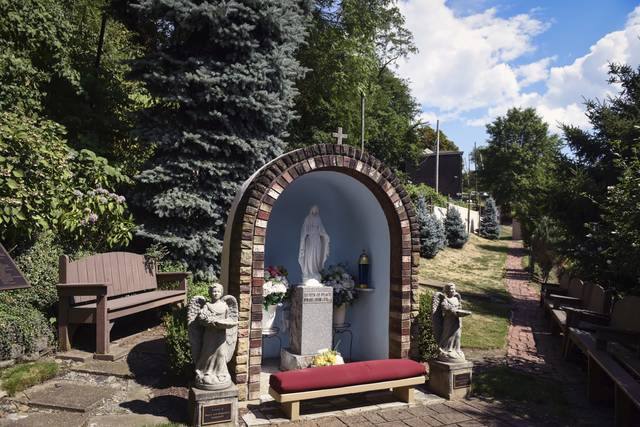Shrine to 'Our Lady of the Parkway' in Oakland may receive historic designation
The Shrine of the Blessed Mother, located on a South Oakland hilltop overlooking the Parkway East and Monongahela River, may soon receive historic designation, after a unanimous recommendation this week by Pittsburgh’s Planning Commission.
The Shrine, created by a collection of community members in the mid-20th century, was blessed in September 1956. It consists of an altar, various planted flowers, walkways and benches, spreading across multiple land parcels and maintained unofficially by area residents.
“It’s all kind of fallen into neighborhood myth as to who was exactly responsible for instigating the shrine,” said Sarah Quinn, a city planner, at Tuesday’s meeting.
“The Shrine is a unique representation of lay Catholic devotion in Pittsburgh, founded and maintained by a community of differing cultural backgrounds,” Quinn said.
The Shrine was nominated for the designation by Preservation Pittsburgh, in partnership with Councilman Bruce Kraus and the neighborhood group. Matthew Falcone, president of Preservation Pittsburgh, said the site’s creation and care over decades by area steel workers from nearby Jones & Laughlin Steel is “full-circle Pittsburgh.”
Its location over Parkway East — often referred to as “Our Lady of the Parkway” — is also significant to the region’s history, Falcone said. Some of the land parcels were originally houses before the creation of the freeway. The Shrine represents the neighborhood’s response to a “drastic transition” from a dense community, he said.
“It is a very complicated site history,” Falcone said. “But I think it is absolutely worthy of recognition.”
Despite its community significance, Quinn said, the Shrine of the Blessed Mother is not considered to be an official shrine of the Catholic Church. No church-owned land was involved in the historic nomination.
Ellen Mady, spokeswoman for the Catholic Diocese of Pittsburgh, confirmed that the church does not own the land discussed by the Planning Commission, but does own the central plot of land where the Shrine is located.
Historically, Mady said, maintenance for the Shrine has been “organic.”
“It’s been cared for by the Catholic men and women of that area, who built it, maintained it, used it as a place of respite or prayer,” she said.
Mady said the diocese is hopeful that any regulations that come with a historic designation will not burden the church or the community members who have made caring and worshiping at the Shrine part of their routine.
Pittsburgh Mayor Bill Peduto expressed support for the historic designation ahead of the Planning Commission’s decision.
“The shrine was created by a diverse group of community members from the South Oakland neighborhood in the 1950s and its location offers architectural and geological features that celebrate this unique and diverse Pittsburgh fellowship,” Peduto said in a statement. “The shrine’s highly visible location has historically provided a place of cultural significance those who pass it — including the steel workers along the river who could look up and see her during the grueling day.”
“This site was created by the community, designed by the community and maintained for generations by the community for the community,” Peduto continued, “and deserves protection through historic designation.”
Remove the ads from your TribLIVE reading experience but still support the journalists who create the content with TribLIVE Ad-Free.



